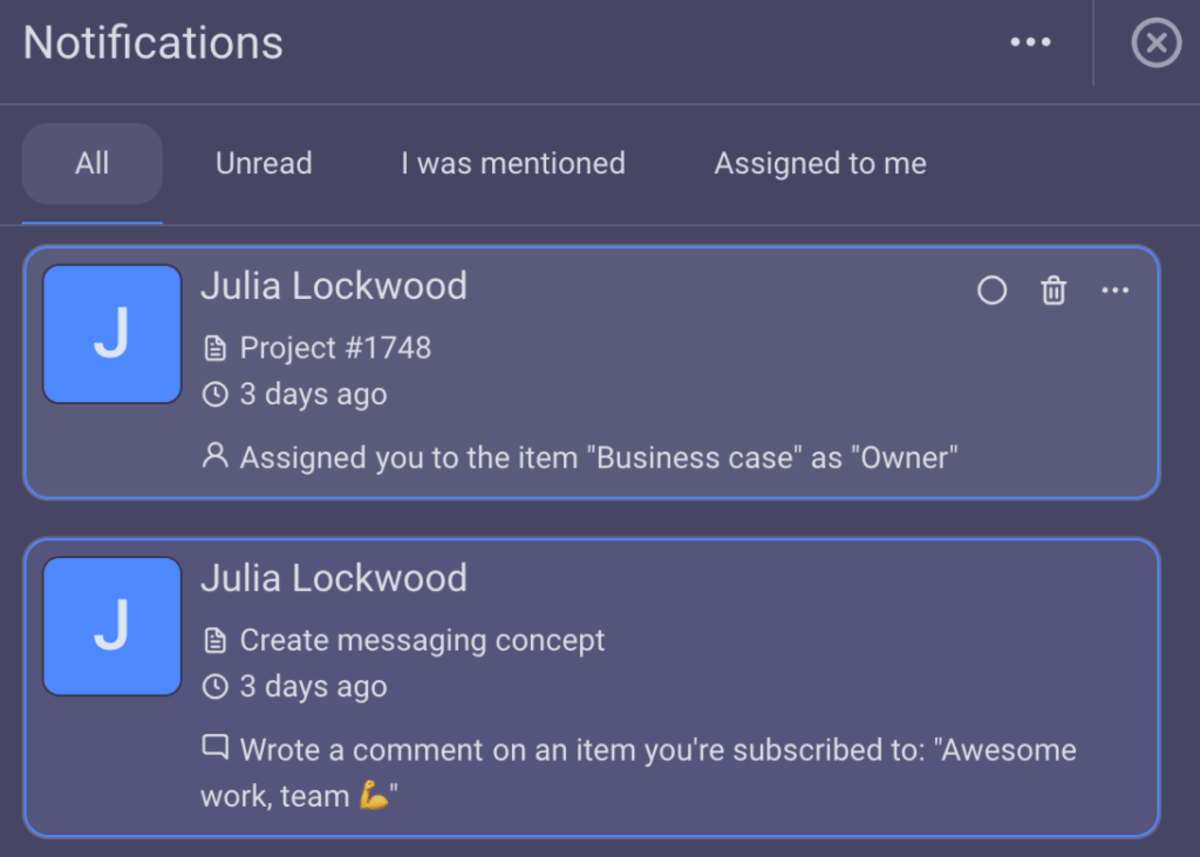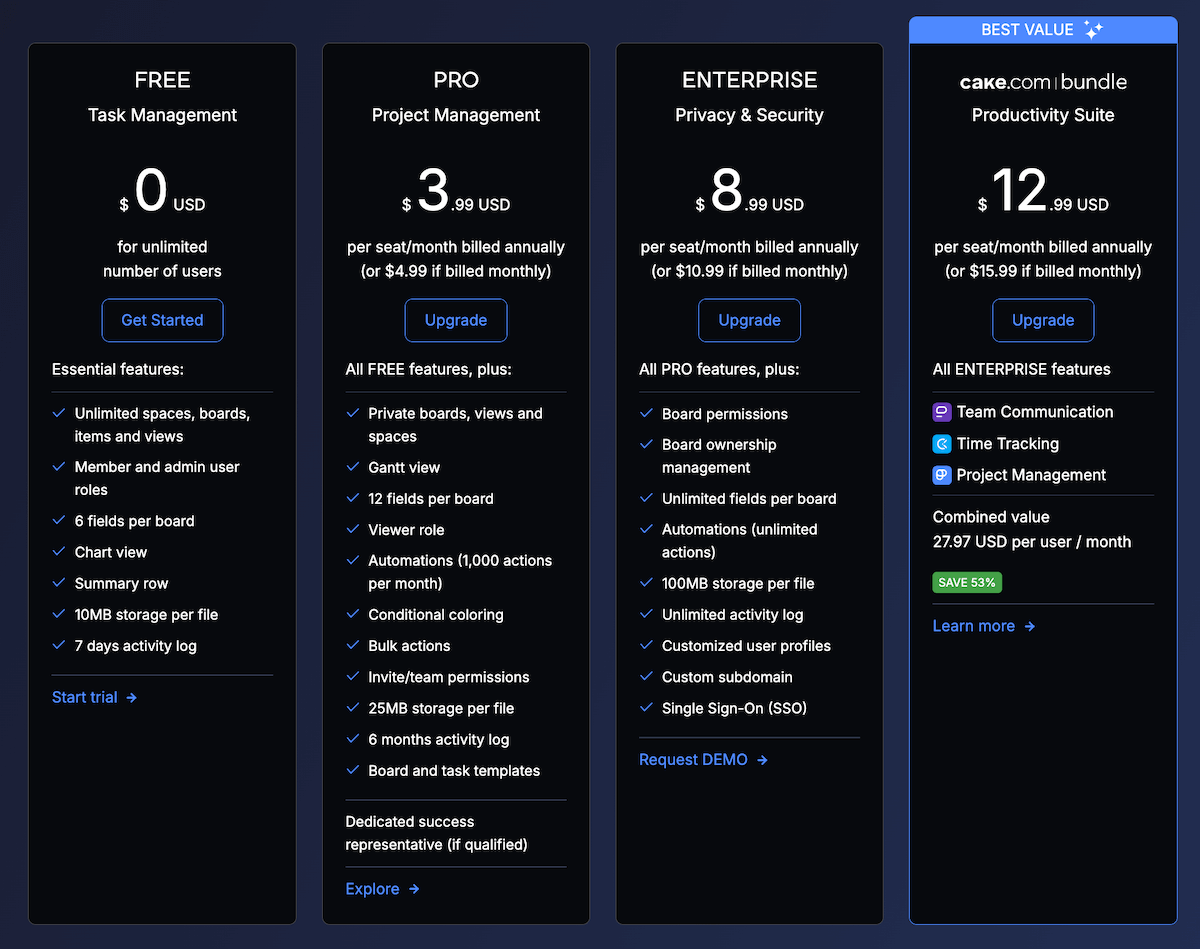If you are running an enterprise and trying to bring your projects into line (no matter what department they are from), enterprise project management (EPM) is your ticket to success.
But, switching from each department running projects according to their own rules and procedures to applying a strategic approach to all projects won’t exactly be a walk in the park.
In case you have no idea what EPM is, what benefits it can bring, or what steps you need to take to implement it, keep on reading.
We’ll help you better understand how EPM works and provide you with some of the best practices to improve your enterprise management skills and run your projects smoothly and efficiently.
Let’s start!

In this article:
What is enterprise project management?
Enterprise project management (EPM) is a strategic approach to managing multiple projects within a large organization by aligning those projects with the overall company’s goals and objectives.
EPM involves the systematic implementation of project management tools, skills, and techniques to all types of projects on a company-wide scale.
In EPM, all projects, regardless of their type, are seen as closely interlinked parts of the company’s strategic framework. So, the purpose of EPM is to set strategies, processes, and tools that will help enterprises streamline their project workflows, direct resources wisely, and achieve business goals successfully.

Enterprise project management vs traditional project management
The main differences between EPM and traditional project management are in their:
- Scope — Traditional project management usually deals with a single project, making sure it is effectively managed throughout all its project phases. EPM handles a project portfolio (all projects within an organization), ensuring strategic alignment, meeting company objectives, and providing value to the company.
- Focus — Traditional project management focuses on project deliverables and finishing projects on time and within budget, while EPM strives to align projects with the company’s strategic goals.
- Reporting — Project managers report to their project teams, stakeholders, and PMOs (project management offices) whereas enterprise project managers keep the C-suite level and EPMO (enterprise project management office) informed.
Run projects with ease — use Plaky
Benefits of enterprise project management
Some of the benefits of adopting EPM within your organization are:
- Improved collaboration — By establishing standardized processes and tools at a company level, EPM prevents working in silos (a lack of a proper information flow and resource allocation within a company) and provides more visibility. Also, EPM usually uses a centralized platform that facilitates information sharing and knowledge transfer.
- Better resource utilization — EPM helps organizations by providing a complete overview of how resources are spent across projects. When organizations know where and when they should direct their resources, they can optimize resource allocation and complete projects more efficiently.
- More efficient decision-making processes — EPM offers real-time data on project progress, resource utilization, and expenditures, which enables project managers to stay up-to-date and make timely decisions based on the latest data.
- Reduced project costs — A structured EPM framework implies aligning projects with overall business objectives. The aim is to hire enough people and avoid investing in projects that don’t bring value to the company. A structured approach and clear processes minimize risks, errors, and delays, which ultimately results in higher productivity and cost reduction.
- Increased project success rate — EPM helps you get an insight into the entire project portfolio so that you can analyze how time, budget, and resources are spent across projects. This approach allows real-time visibility and better project control, which makes it easy to identify bottlenecks, manage risks, and respond to challenges. As a result, your teams can work more efficiently and ensure project success.
The importance of EPMOs within organizations
Working on projects in a large enterprise can get really complicated. You may quickly get caught in a tangled web of different project practices and tools — and totally lose control over your projects and resources.
But, that’s exactly where an EPMO comes into play.
We reached out to Alan Zucker, an experienced PMP professional and project management consultant, to learn what EPMO actually does:

“The enterprise PMO typically provides guidance and oversight to all of the project organizations within the enterprise. The EPMO may establish standards, guidelines, templates, etc. It may ’own’ the enterprise project management tools. They often provide executive reporting.”
Still, the question that naturally arises is whether all organizations need an EPMO.
We got the answer from Carla Smith, MBA, PMP, PHR, an experienced project manager with a rich background in working with both small and enterprise clients. She explained that the answer depends on 3 factors:
- The size of the organization,
- The size of the project, and
- Who is delivering the project.
According to Carla, you should think of an EPMO in the following situation:

”If delivering goods or services to clients of all sizes, and there is a high volume of projects AND pricing, scope, deliverables, etc., vary by client size — then YES, a separate team/ENT PMO focused on these clients usually works best, given the projects will vary (based on client expectations, scope, timeline, complexity, onboarding and more).”
On the other hand, there are certain cases when EPMOs might not be necessary:

“If projects are mostly internal initiatives, I would think, NO [EPMOs might not be necessary]. If the delivering organization is fairly small or young, and PM resources tend to lead a bit of every type of project, I would say NO.”

What is the role of an enterprise project manager?
The main responsibility of enterprise project managers (EPMs) is to oversee company-wide project management.
Though their duties vary from one company to another, EPMs usually deal with the following:
- Strategic alignment — EPMs ensure all projects are in sync with the strategic goals and objectives of an organization.
- Project portfolio development and management — As EPMs oversee all projects, their job is to develop a long-term strategy that covers the entire project portfolio. Also, EPMs manage the portfolio by handling project prioritization, resource allocation, and risks so that projects can deliver desired outcomes.
- Adoption of uniform project management practices across an organization — EPMs deal with the adoption of shared practices on a large scale and promote project management culture across the enterprise. They also oversee staff and management education and mentoring.
- Resource management — By having an overview of the company’s project portfolio, EPMs can optimize resource allocation, including people, budget, and tools. They manage how resources are used across multiple projects and make sure they are properly distributed.
- Stakeholder engagement — EPMs and EPMOs report to senior management and provide them with updates on the project portfolio. This way, they ensure alignment and establish a close rapport with stakeholders.
- Performance monitoring — EPMs monitor project progress by receiving regular feedback from project managers about project issues, risks, and challenges. Using feedback, EPMs provide guidance and offer solutions to keep projects on track.
- Continuous improvement — EPMs identify the need for corporate process improvements and aim to implement the best practices that can effectively drive change within the organization.
Enterprise project management methodologies
Some of the most common EPM methodologies are:
- Waterfall — Organizations that opt for Waterfall prefer running projects in sequential order, i.e., they start a new phase only when the previous one has been fully completed. This methodology ensures fixed processes, systematic planning, and clearly defined roles.
- Agile — This methodology is focused on collaboration and has the ability to adapt to changing environments, i.e., it supports flexibility. Organizations using this approach prefer working in Sprints, and they can easily make necessary adjustments during project execution.
- Six Sigma — If Six Sigma is your choice, your organization is probably focused on increasing customer satisfaction. This methodology is data-driven and supports thorough analysis so that you can control and improve your projects and processes.
- Lean — This approach is based on Toyota’s business values. It focuses on careful planning and a high level of product quality. Lean methodology minimizes time waste and prevents overspending. By offering streamlined processes, this approach adds greatly to customer satisfaction.
- PRINCE2 — PRINCE2 is easily adapted to any sort of project. By opting for this methodology, you can count on clearly defined project roles and processes. Some of its principles are learning from experience, splitting the project process into manageable stages, and focusing on products.
Bear in mind that there’s no one-size-fits-all methodology and that you should choose the one that best fits your organization’s culture and needs.
💡 Plaky Pro Tip
Choosing the right project management methodology can be tricky. Find more detailed information on various PM approaches in the article below:
7 elements of enterprise project management
Based on a PMI paper on building effective enterprise project management (EPM), there are 7 elements of EPM.
#1 Risk analysis
Risk analysis is complex in EPM. Since EPMs carry it out at an organization-wide scale, they need a deep understanding of the company goals and strategies as well as the project portfolio.
Risk analysis helps EPMs detect, assess, and manage project risks, as well as develop mitigation strategies that prevent undesirable consequences.
💡 Plaky Pro Tip
Risk management is crucial in project management, especially on an enterprise level where projects usually have little margin for error. Have a look at the articles below to find out how you can manage risks effectively:
#2 Structured estimating
Estimating project costs, various resources, and time is a must in project planning. EPMs provide guidance and set standards for project estimation and budgeting for all project teams.
Accurate estimation, often based on lessons learned from previous projects, enables better resource allocation, reduces project risks, and enhances the project’s chances of success.
#3 Project reviews
EPM encourages regular assessment of project progress and values project performance tracking as a means to stay in tune with the organization’s business goals.
With EPM, project reviews are periodic, and they focus on checking project standards, status, and issues. They can also evaluate if risk mitigation plans require updates.
Project reviews consider 4 areas:
- Delivery,
- Client,
- Team, and
- Budget.
One method of reporting about these aspects is to categorize them by assigning different colors (red/yellow/green) to each. The red color is typically assigned to projects that need to be prioritized, in which case EPMs may intervene.
#4 PM coaching
Coaching and training for project managers are essential as they get a chance to improve their skills and practices.
EPMs and EPMOs are in charge of providing guidance and support to project managers when dealing with project planning, decision-making, or using project management tools.
Coaching is also a great way to foster a culture of open communication and develop a close-knit company culture.
#5 Escalated issue management
The truth is — project conflicts and escalations are inevitable in large organizations. However, when issues can’t be solved by a team lead or project manager, they move up to higher levels of the project hierarchy.
What can really do the trick is to establish clear escalation paths and develop common processes you’ll apply to all departments. This helps EPMOs identify issues right on time and find solutions to put projects back on course.
#6 Time accounting
By tracking the time spent on project tasks and activities, you can monitor progress, identify potential blocks, and make timely decisions and adjustments.
With efficient time tracking tools, EPMs can oversee projects and analyze data that can help them develop guidance for efficient project planning and time estimation.

#7 Information system
EPMs could hardly work without a centralized information system that helps them handle all project-related data. By integrating appropriate project management software into your organization, you can:
- Manage projects with more ease,
- Get data-driven insights into your projects’ status,
- Track their progress in real time,
- Set deadlines effectively, and
- Ensure data security.
With such a tool, you can gather a project team, reduce errors, and ensure a seamless project workflow.
Plus, your EPM software is of great use when you need to do a detailed analysis of project data, which should help you make informed decisions aligned with the company’s strategy.
Organize your projects in Plaky
How to implement enterprise project management
If your organization struggles to keep track of ongoing projects and finds it difficult to control them, you should consider transitioning to EPM.
Here’s a breakdown of the steps you need to take to implement EPM in your organization.
#1 Determine how your organization will apply EPM
Depending on the business goals of your organization, you need to clarify what you actually expect to get after you implement EPM. Start by considering the following questions:
- What are your current project processes, and how do you expect EPM to address them?
- What resources do you need to start the transition?
- What responsibilities will an EPMO have when established?
- Who will take on the new roles and ensure accountability?
- What are the potential challenges of implementing EPM?
#2 Involve the stakeholders and secure their buy-in
Your next step is to involve the stakeholders in the process and secure their buy-in. After all, that’s the first hurdle you need to clear.
Zucker explains what you need to highlight to get the green light from your stakeholders:

“Getting executive buy-in is often a challenge. Focusing on the ’what’ and ’why’ and the value delivered is an effective way to create alignment among the critical stakeholders.”
Your stakeholders’ feedback is vital for successful EPM implementation as they can:
- Consider the benefits of such transition,
- Express concerns, and
- Critically evaluate how the organization may benefit from EPM.
#3 Align projects with the organizational strategy
Once you implement EPM, you need to analyze your project portfolio in detail, identify dependencies and risks, and find areas for improvement.
This means you have to evaluate projects and see how they contribute to your business goals. When you get the whole picture, you can decide if you need to refocus some of the projects or even wind down those that don’t bring value to the organization.
#4 Select a methodology and choose the right software
Your chosen project management methodology should reflect your company culture and align with your company’s goals and needs. Also, by using one methodology, you’ll get all project managers on the same page.
Once you introduce EPM, you’ll also need to deploy a system that will support all your project management processes, including scheduling, time tracking, progress management, and accounting.
💡 Plaky Pro Tip
Having trouble finding the right PM software? We’ve got you covered! Click below to find out how to choose the best tool:
#5 Establish a project support office (PSO)
The project support office (PSO) serves as an EPMO’s right hand. While EPMO is concerned with company strategy, PSO can provide support on a daily basis in areas like:
- Project planning — helps create budgets, set timelines, and come up with communication plans,
- Project identification — analyzes a project’s impact on the organization,
- Auditing — participates in project performance review and suggests options for improvement,
- Resource allocation — tracks project resources and helps with their proper allocation,
- Project execution — assists in project risk analysis, progress tracking, and project communication.
#6 Enable clear communication channels
Clear communication protocols, based on your EPM framework, will ensure an effective information flow resulting in better employee collaboration.
Open communication facilitates project activities, keeps everyone in the loop, and leaves no room for misunderstanding.


#7 Provide training and support
Ongoing support and a unique coaching system are a must if you want successful EPM implementation.
By providing adequate training to your staff, you can help them upgrade their management and technical skills so that they can use that knowledge to carry out EPM practices.
#8 Monitor the EPM implementation process
Finally, a regular assessment of your EPM rollout plan is necessary to check the status of your EPM implementation.
Just like you would track progress on any other project on a department/team level, you should evaluate current EPM processes, identify potential challenges, and consider the alignment of your EPM model with strategic goals.
Ideally, you should also gather feedback from your stakeholders as they might suggest areas for improvement of processes and tools.
Monitor your projects closely with Plaky
How do enterprise environmental factors affect your PM plan?
Enterprise environmental factors (EEFs) are situations that can seriously affect your project plan and are usually beyond the control of your project team.
Some of the most common EEFs are:
- Market conditions — customer demand, inflation, availability, and competition,
- Legal requirements — relevant laws, permits and regulations,
- Organizational culture — organization’s vision, values, management style, and work environment,
- Resource availability — human, financial, technological, logistical, and physical,
- Political and social climate — social norms, local customs, public opinion, political stability/instability, and government policies,
- Technological standards — product quality, network protocols, safety, security, communication protocols, and others.
EEFs can be your friends or foes, so make sure you understand their significance and plan your projects with them in mind. Why?
Well, in short, you can’t expect your product to make it big on the market if there’s a low demand. Also, governments can have fluctuating policies, so you have to be ready to adapt your project to changing circumstances.
EEFs can determine how your project is executed, how you manage available resources, and how you map out a risk mitigation strategy.
The good thing is you can face EEFs by identifying them on time. Make sure you follow market trends, analyze your organization’s policies, and keep stakeholders up-to-date. You can also rely on lessons learned and consider what EEFs often repeat and how you dealt with them.
EEFs have a huge role in how your company manages projects and can ultimately decide their future. This is why it’s important to recognize them and address them properly.

Best practices for successful enterprise project management
Here are some best practices to consider to ensure your EPM implementation goes without a hitch.
#1 Get stakeholders on your side
EPM initiatives should get active support from stakeholders. This is why building trust and creating a culture of confidence between EPMs and stakeholders is vital.
By providing regular updates on EPM activities and performance status — through established communication channels — EPMs get regular feedback from stakeholders and ensure efficient implementation.
#2 Foster a collaborative culture
Organizations fostering a collaborative culture usually encourage open communication, teamwork, and shared accountability. Leaders should create a supportive environment where team members share the same goals and respect each other.
💡 Plaky Pro Tip
Don’t know how to introduce cross-functional collaboration across the organization? Read the article below and find out how:
#3 Be mindful of potential risks
Risk management in large organizations usually involves developing risk mitigation strategies — so make sure you have an action plan.
What EPMOs usually do, as part of their risk management processes, is form a risk response team that deals with potential risks, analyzes them, and responds properly.
#4 Encourage continuous improvement
EPM implementation is not a one-time-only activity. In fact, it is an ongoing process that requires constant monitoring and development.
You should make periodic checks of your EPM practices and make sure they still align with your business objectives. Regular evaluation of EPM tools, project portfolio performance, and EPM practices will help you spot opportunities for improvement.
#5 Carry out regular performance reviews
Finally, remember that there’s no better way to check your project performance than by monitoring it on a regular basis. By tracking project performance against the project plan, you can identify deviations from it and react on time.
Steer your enterprise projects to success with Plaky
Enterprise project managers need a trusty assistant to help them plan projects, track their progress, and provide them with real-time updates.
This is where the right project management app (PM app) definitely comes in handy.
Your chosen PM software should help you:
- Organize your project tasks and subtasks with ease and track their status in real time so that you can make timely adjustments,
- Enable seamless communication and collaboration among co-workers so that everyone is on the same page at all times,
- Ensure absolute control over who has access to what information and prevent sensitive information from being revealed,
- Provide first-rate security and keep your project data safe so that it never falls prey to outside attackers, and
- Monitor how much time is spent on tasks and projects and make better estimates in the future.
Luckily, Plaky is a robust but simple-to-use platform that encompasses all these components and supports enterprises in meeting their strategic objectives.
In Plaky, you can visualize your projects the way you prefer:
- Table view (default) — Get an overview of your project tasks, dates, assignees, and other relevant fields in the form of a list.
- Gantt view — Display your entire project timeline in the form of a horizontal bar chart to detect potential bottlenecks and spot overlaps in your enterprise’s hectic schedule.
- Kanban view — Get a visual overview of your tasks categorized by columns for easier progress tracking. In Kanban view, you can reorder columns to better prioritize tasks and ensure a balanced workflow.
- Chart view — Gain insights into your projects and their performance through pie and bar charts that you can use for in-depth data analysis.

Plaky is also fully flexible and customizable, allowing you to use custom fields to upgrade the task information structure and avoid misunderstandings. You can use these fields to:
- Set start and due dates,
- Assign people to their tasks,
- Set task priority status, or
- Describe what needs to be done.
Tracking task progress is also pretty effortless in Plaky, as the app sends you real-time notifications whenever there’s an update to a task — so you’ll never miss a thing.
And, since enterprises usually have multifaceted projects and a bunch of repetitive tasks, Plaky has got you covered with board automations too.
These automations can help you stay focused on priority tasks rather than waste time on basics. By using the formula When something happens (Trigger) → Then do something automatically (Action), you can apply automations to items, subitems, or a combination of both and save precious time.

Another perk is that Plaky serves as a centralized file-sharing hub. You can store, organize, and manage all your project documentation. Bonus: you get unlimited storage, which, no doubt, represents a great asset to enterprises.
Best of all — Plaky offers an Enterprise plan that sets no limits to your enterprise project management. At only $8.99 per seat/month, you get:
- Unlimited storage (100 MB per file),
- Board permissions, board ownership, and unlimited fields per board,
- An unlimited activity log,
- Customized user profiles,
- Unlimited automations, and much more.

Don’t let your enterprise projects veer off course! Start your free 14-day Plaky trial now!

